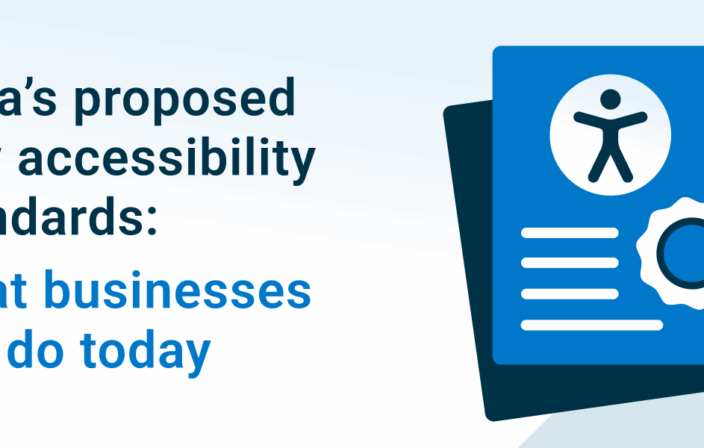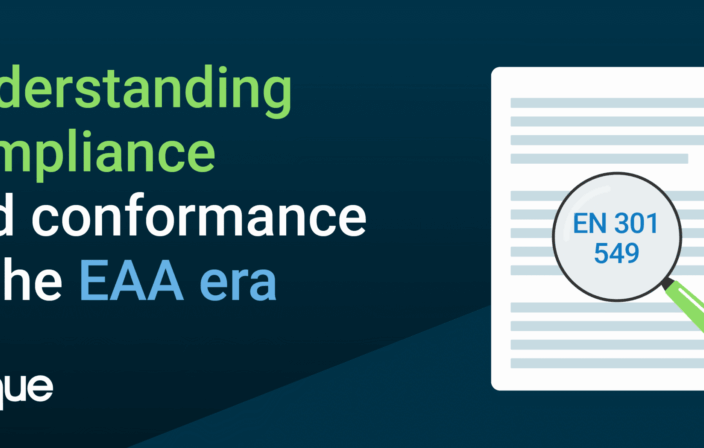In celebration of this year’s Global Accessibility Awareness Day (GAAD), let’s take a look at the state of accessibility.
Accessibility is continuing to grow and change; downloads for axe are exponentially increasing, key players like Microsoft and Google are investing more in accessibility, and our clients are forming successful and sustainable accessibility programs.
In this post, we will review the changes in regulations, user trends, accessibility trends, the state of accessibility for key industries, and accessibility predictions for 2019. If you’d like, you can view our on-demand webinar that covers the details below.
Regulations and Litigation in the Absence of Regulations
In our 2018 “State of Accessibility” update, the major regulation update was the Section 508 Refresh. A few additional updates have happened since then.
European Accessibility Act
The European Accessibility Act had a preliminary signing in November 2018 with the final adoption put in place by the European Parliament this April. This act expands accessibility to public services beyond the public sector, including e-commerce, transportation, banking, etc. It is important to note this regulation includes web and native mobile accessibility. Mobile applications are becoming integral to our lives and, therefore, to accessibility.
21st Century Integrated Digital Experience Act (IDEA)
In December 2018, President Trump signed the 21st Century Integrated DIgital Experience Act (IDEA). This act requires federal agencies to modernize their websites. This modernization includes accessibility which will apply to internal and external apps for the federal government.
The responsibility of accessibility falls to the head of the agency. Furthermore, CIOs are required to make sure there is enough budget and resources to fulfill the requirements. CIOs are also required to report on the status of this new requirement. This makes federal agencies more accountable for their accessibility than the current Section 508 standards.
Web (and mobile) ADA Lawsuits Continue to Increase
Although the Department of Justice has reiterated that ADA Title III does apply to websites, they continue to refuse to provide specific compliance requirements. This lack of a single overarching regulation has led to an increase in web and mobile ADA lawsuits. From 2014 to 2017, there has been a steep increase in total ADA lawsuits. In 2018 there was an extreme 181% increase in web-based ADA lawsuits.

In the first quarter of 2019, 20% (~420) of ADA lawsuits filed were related to web accessibility. The plaintiffs for these lawsuits are also starting to include other disability types, not just people who are visually impaired.
User Trends
Our use of mobile devices, home assistants, and other devices on the “Internet of things” continues to increase. Additionally, there is a strong need for online enablement of things like payments, delivery services, and other day-to-day consumer activities. As our lives become more and more dependent on online transactions and interactions, digital personalization is a must-have requirement for a user’s online and e-commerce experiences. For many of us, these innovations have made our lives more convenient and more productive. For people with disabilities, the proliferation of online services means a level of independence that no previous generation could have experienced. Making these services and technologies accessible is critical and life-changing for so many of these users.
Deque is currently partaking in a research project with a research firm, the complete report will be released shortly. Initial findings show that approximately 40% of websites are inaccessible to the blind. Additionally, the remaining 60% that are somewhat accessible pose barriers in terms of partial accessibility, regression of accessibility, and common features that are blockers such as Captchas. More importantly, blind internet users abandon two companies a month because of web inaccessibility.
In fact, nine out of ten blind internet users are vocal anti-advocates for inaccessible companies. This usually expands to friends and family, which is a great risk to your overall brand. Lastly, blind internet users call customer service center once a week because of web accessibility. The cost of a call to a customer service center is $40 compared to an online interaction of 2 cents.
Beyond litigation, it is important to note that 1 in 3 people between the age of 65-74 experience hearing loss. When put into context of the video trend, it is very important to provide captions, subtitles or sign language for this content. English as Second Language users will also benefit from simple language. People with cognitive disabilities (e.g. autism, Alzheimer’s, traumatic brain injuries, etc.) increase the need for making the web simple and easy to use. Not to mention, in a world of many devices, we all need simple experiences that don’t require a large attention span.
Accessibility Trends
This year’s accessibility trends range from technological improvements, an increase in downloads for open source accessibility testing tools, and awareness increasing around cognitive disabilities:
- Machine learning is a new and great tool for accessibility. For example, Microsoft’s image recognition from Azure is successful in identifying and tagging images with confidence.
- Microsoft’s image recognition in the Google Cloud version can annotate with a great level of confidence. The possibility of automating accessibility is continuously expanding.
- Visible and public physical accessibility is increasing on Google Maps and Yelp, by indicating infrastructure and establishments that are accessible.
- Open source tooling is increasing, illustrating that awareness in the developer community is becoming more mainstream. Axe weekly downloads increased 5 times in the span of one year. Chrome lighthouse developer tools, Microsoft’s Accessibility Insights tool, and Pa11y are all user the axe rules library.
- The level to which automation can catch accessibility violations is expanding. Axe added seven new rules in the last year, and the team is expected to release five more rules this year.
- Awareness around cognitive disabilities is increasing. There are around 16 million people with cognitive disabilities (2X the population of NYC). As the population continues to age, this will become an increasingly pressing issue for accessibility. The good news is that the World Wide Web Consortium (W3C) cognitive accessibility task force is continuing to make strides in how the community can test for cognitive disabilities on web and mobile platforms.
Annual Survey of Accessibility in Various Industries
Each year, I scan and survey the homepages of the top fifty global websites using axe. This year, there is an average of 120 accessibility violations on the homepages of the top fifty global websites. Below are the surveys of the top five sites for each industry. These numbers are violations found by automated accessibility scans from axe.
Financial Services Industry
From 2018 to 2019, Financial services websites had a 50% regression of accessibility, from 61 to 74 average violations per page.

Airline Industry Websites
Airline organizations, who are now passed the deadline for the Air Carrier Access Act (ACAA), saw an increase in average accessibility violations from 30 to 59 defects per page for the top five US airlines.

Retail Industry
The good news is that retail organizations are improving in overall average accessibility. This is most likely correlated with the increase of web accessibility related lawsuits. The top 5 retail sites went from an average of 46 to 32 accessibility violations per page from 2018 to 2019.

Healthcare Industry
The healthcare industry increased in the average number of accessibility violations for the top five websites and continues to have a higher average compared to other industries.

FedGov Top Ten Websites
Below are the top ten websites for the federal government. There are a few outliers of very low average violations in this group.
| Site Home Page | 2019 Violations |
|---|---|
| Energy.gov | 12 |
| Faa.gov | 0 |
| Dhs.gov | 82 |
| Nih.gov | 2 |
| Treasury.gov | 17 |
| Cia.gov | 82 |
| Census.gov | 32 |
| Occ.gov | 23 |
| Omb.gov | 6 |
| Epa.gov | 2 |
Accessibility Predictions
Last year, we predicted that the future of accessibility would focus on pictures, voice, augmented/virtual reality, customer support, and user experience. This year, we predict that in 2019 the accessibility industry will focus on the following:
- Companies will want to lower the cost of accessibility while simultaneously ensuring that the software development velocity isn’t lost. This will, in turn, increase their customer base, engagement, and retention in addition to being compliant.
- Users will want to participate fully in the digital revolution and transformation, and this demand for an equal experience will continue in their efforts to hold companies accountable through lawsuits.
- Regulators want to ensure accessibility isn’t overlooked, they don’t want to be in the business of being the overseers.
- Millennials will continue to push for social justice and disability rights, calling for companies to treat their users with empathy.
- Accessibility will continue to shift left in the software development life cycle and automation will advance its coverage of accessibility.
- Open source rules for accessibility will expand to include more metrics and reporting.
Summary
Now that you have a primer on accessibility trends from 2018, you know that accessibility is growing in awareness and testing capability for 2019. Awareness days like Global Accessibility Awareness Day play a huge part in this momentum. A great way to push for more accessibility at your organization is to show your management how accessibility is becoming more mainstream and that people with disabilities are a market you cannot ignore.



